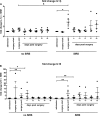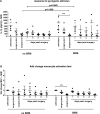Identification of Predictive Early Biomarkers for Sterile-SIRS after Cardiovascular Surgery
- PMID: 26263001
- PMCID: PMC4532358
- DOI: 10.1371/journal.pone.0135527
Identification of Predictive Early Biomarkers for Sterile-SIRS after Cardiovascular Surgery
Abstract
Systemic inflammatory response syndrome (SIRS) is a common complication after cardiovascular surgery that in severe cases can lead to multiple organ dysfunction syndrome and even death. We therefore set out to identify reliable early biomarkers for SIRS in a prospective small patient study for timely intervention. 21 Patients scheduled for planned cardiovascular surgery were recruited in the study, monitored for signs of SIRS and blood samples were taken to investigate biomarkers at pre-assigned time points: day of admission, start of surgery, end of surgery, days 1, 2, 3, 5 and 8 post surgery. Stored plasma and cryopreserved blood samples were analyzed for cytokine expression (IL1β, IL2, IL6, IL8, IL10, TNFα, IFNγ), other pro-inflammatory markers (sCD163, sTREM-1, ESM-1) and response to endotoxin. Acute phase proteins CRP, PCT and pro-inflammatory cytokines IL6 and IL8 were significantly increased (p<0.001) at the end of surgery in all patients but could not distinguish between groups. Normalization of samples revealed significant increases in IL1β changes (p<0.05) and decreased responses to endotoxin (p<0.01) in the SIRS group at the end of surgery. Soluble TREM-1 plasma concentrations were significantly increased in patients with SIRS (p<0.01). This small scale patient study could show that common sepsis markers PCT, CRP, IL6 and TNFα had low predictive value for early diagnosis of SIRS after cardiovascular surgery. A combination of normalized IL1β plasma levels, responses to endotoxin and soluble TREM-1 plasma concentrations at the end of surgery are predictive markers of SIRS development in this small scale study and could act as an indicator for starting early therapeutic interventions.
Conflict of interest statement
Figures




References
-
- Bone RC, Balk RA, Cerra FB, Dellinger RP, Fein AM, Knaus WA, et al. ACCP/SCCM consensus conference: Definitions for sepsis and organ failure and guidelines for the use of innovative therapies in sepsis. Chest. 1992;101:1644–55. - PubMed
MeSH terms
Substances
LinkOut - more resources
Full Text Sources
Other Literature Sources
Research Materials
Miscellaneous

